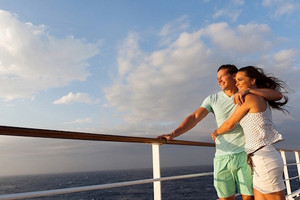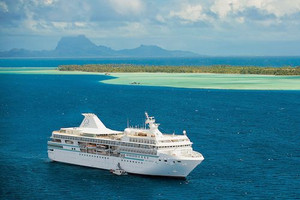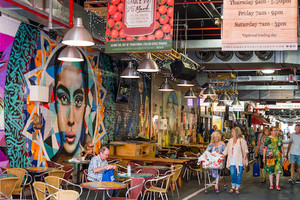
A long arc of small islands, the Southern Caribbean’s Lesser Antilles is a geographically and culturally diverse region with enduring appeal.
It is easy to understand why the Caribbean archipelago is one of the world’s top regions for a cruise vacation. Its warm, turquoise waters are home to a smorgasbord of landscapes and exotic islands boasting movie-set beauty; coconut-tree-clad mountains, verdant valleys of sugar cane and bananas, towering volcanoes, sun-drenched beaches, and coral reef teeming with colourful marine life. Although the region is divided into two areas, the Greater Antilles to the north and the Lesser Antilles to the south, the latter group of islands is less well known among cruising circles. As more cruise lines begin to feature these islands on itineraries, however, cruise fans are quickly discovering their unique appeal.
The Lesser Antilles is made up of the southern Windward Islands, the northern Leeward islands, and the former Netherlands Antilles in the west. The Windward chain has eight primary islands; Dominica, Martinique, Barbados, St. Lucia, Saint Vincent and the Grenadines, Grenada, Trinidad and Tobago. Dominica has been dubbed the “nature island” thanks to a wealth of natural wonders including the world’s second largest boiling lake, 365 rivers and rich marine life. Sparsely populated, tropical forest covers two-thirds of the land, and its Morne Trois Pitons National park was the first UNESCO World Heritage Site in the eastern Caribbean.
Just kilometres away, and discovered by Christopher Columbus in 1502, Martinique is one of the more refined of the larger islands, and a genuine slice of France nestling in the tropics. It is dominated by towering Mount Pelée, and while the southern half of the island is where you’ll find stunning beaches, the northern half is enveloped in lush rainforest. Often referred to as the “Little England” of the Caribbean because of its long stint as a British colony, Barbados an island of two quite different halves. The eastern side stretches along rugged Atlantic coast and is popular with surfers, while the western side is quieter and more calm with tranquil bays ideal for snorkelling. A popular sightseeing spot here is Harrison’s Cave, a bizarre subterranean environment which can be accessed by a tram.
In history, St. Lucia was juggled between French and British control so frequently that its other name is the "Helen of the West Indies", after the mythical Helen of Troy. More mountainous than any other Caribbean island, its highest point is Mount Gimie which towers 950 metres or 3,120 feet above sea level. Also volcanic, and possessing a mountainous terrain, St. Vincent was the picturesque setting for the popular Pirates of the Caribbean series of movies, while Grenada, notoriously invaded by the US in 1983, is one of the world’s largest exporters of spices including nutmeg, cinnamon and cloves, and a culture with a passion for cuisine.
The Leeward Islands is a larger island group including the US and British Virgin Islands, Virgin Islands, Saint Martin/Sint Maarten, Antigua, Saint Kitts, Nevis and Monserrat. Although it’s an unincorporated organised territory of the United States, the US Virgin Islands used to be known as the Danish West Indies. Its three primary islands include St. Croix, Saint John and Saint Thomas, with the latter being the most popular when it comes to cruise itineraries, thanks to two main draw cards: duty free shopping, and a picturesque spot called Magen’s Bay with two kilometres of white sanded beachfront.
Antigua, which until 1981 was British, is a famous island paradise for the rich and famous known for scuba diving, sailing and five-star resorts. In contrast, Monserrat, which is still a British overseas territory, is famous for the Soufrière Hills Volcano which erupted dramatically in 1995, destroying much of the Georgian capital city of Plymouth. Pick of the more unique islands in this region is Saint Martin/Sint Maarten, one of the smallest land masses in the world divided between two countries. The French half, Saint Martin, occupies the north and is famous for shopping; in contrast, the southern half, held by the Dutch, is famous for beaches, casinos and a festive nightlife.
Lying north of the Venezuelan coast, Aruba, Bonaire and Curacao are part of what used to be the Netherlands Antilles until last year. Curaçao, the best known island, was once the centre of the Caribbean slave trade. Today, however, it is a popular tourist destination famous for the colourful architecture of its capital city, Willemstad, reminiscent of a Dutch town. In contrast, the island of Bonaire is flat with little vegetation except for sandy beaches and salt hills, while Aruba has a cactus-strewn landscape and a lively capital city, Oranjestad, with an equally colourful history. The islands of the southern Caribbean continue to possess a strong colonial flavour fused with West Indian charm. As archipelagos go, they are as unique as they are picturesque, with plenty of excitement on offer, and much for cruise fans to experience.
For luxe-for-less cruise deals to the Southern Caribbean, visit our sister website www.luxuryholidaybargains.com.au.
- By:
- Joanna Hall






